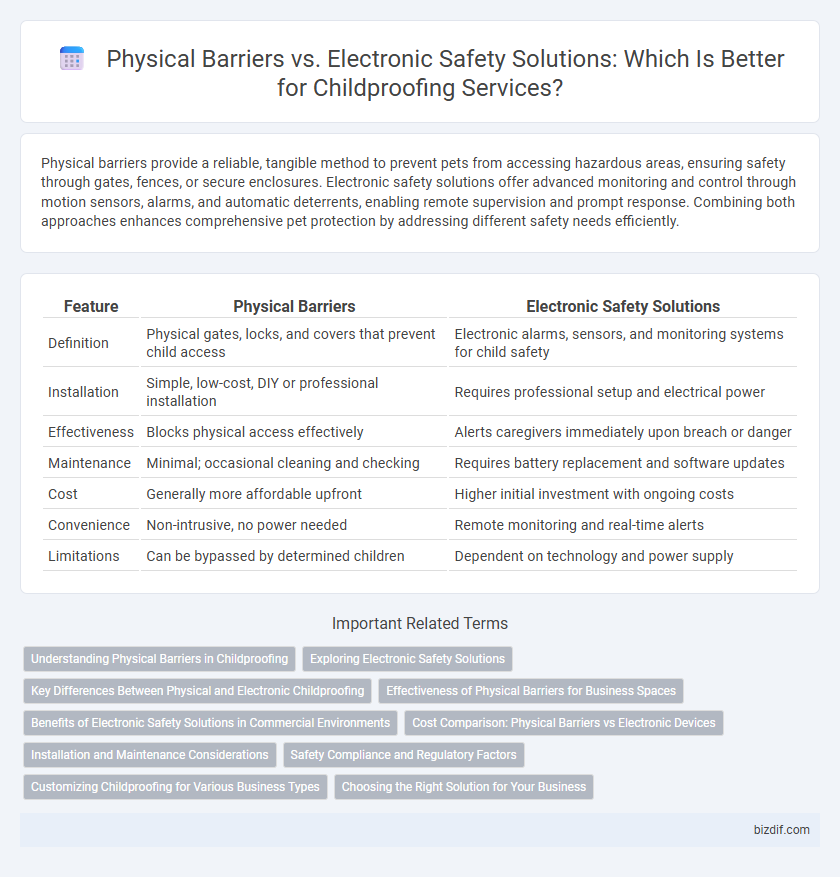Physical barriers provide a reliable, tangible method to prevent pets from accessing hazardous areas, ensuring safety through gates, fences, or secure enclosures. Electronic safety solutions offer advanced monitoring and control through motion sensors, alarms, and automatic deterrents, enabling remote supervision and prompt response. Combining both approaches enhances comprehensive pet protection by addressing different safety needs efficiently.
Table of Comparison
| Feature | Physical Barriers | Electronic Safety Solutions |
|---|---|---|
| Definition | Physical gates, locks, and covers that prevent child access | Electronic alarms, sensors, and monitoring systems for child safety |
| Installation | Simple, low-cost, DIY or professional installation | Requires professional setup and electrical power |
| Effectiveness | Blocks physical access effectively | Alerts caregivers immediately upon breach or danger |
| Maintenance | Minimal; occasional cleaning and checking | Requires battery replacement and software updates |
| Cost | Generally more affordable upfront | Higher initial investment with ongoing costs |
| Convenience | Non-intrusive, no power needed | Remote monitoring and real-time alerts |
| Limitations | Can be bypassed by determined children | Dependent on technology and power supply |
Understanding Physical Barriers in Childproofing
Physical barriers in childproofing include gates, cabinet locks, and corner guards designed to prevent access to hazardous areas and objects. These tangible solutions provide reliable, immediate protection by physically blocking children's access to stairs, sharp edges, or toxic substances. Understanding the strengths and limitations of these barriers helps parents create a safer home environment tailored to their child's developmental stage and mobility.
Exploring Electronic Safety Solutions
Electronic safety solutions in childproofing incorporate smart technology such as motion sensors, smart locks, and alarm systems to create dynamic protection that adjusts to a child's activity and environment. These high-tech devices provide real-time monitoring and alerts, enhancing security beyond static physical barriers like gates or covers. Integrating connected safety solutions with home automation systems enables parents to remotely control access and receive notifications, significantly reducing the risk of accidents in the home.
Key Differences Between Physical and Electronic Childproofing
Physical barriers in childproofing include gates, cabinet locks, and corner guards designed to create tangible obstacles that prevent access to hazardous areas. Electronic safety solutions utilize technology such as motion sensors, alarms, and smart locks to monitor and alert caregivers about potential dangers remotely. Key differences lie in physical barriers providing constant, passive protection while electronic systems offer dynamic, real-time monitoring and control.
Effectiveness of Physical Barriers for Business Spaces
Physical barriers provide reliable and tangible protection in business spaces by preventing unauthorized access and reducing potential hazards. Their durability and low maintenance make them an effective choice for consistently safeguarding employees, customers, and sensitive areas. Unlike electronic safety solutions, physical barriers do not rely on power or connectivity, ensuring uninterrupted security and childproofing in high-traffic commercial environments.
Benefits of Electronic Safety Solutions in Commercial Environments
Electronic safety solutions in commercial environments offer advanced monitoring and instant alerts, significantly reducing response times to potential hazards. These systems integrate seamlessly with existing security infrastructures, enabling real-time data analytics and remote management that physical barriers cannot provide. Enhanced adaptability and scalability of electronic solutions ensure continuous protection as business needs evolve, improving overall safety and compliance.
Cost Comparison: Physical Barriers vs Electronic Devices
Physical barriers such as gates, locks, and corner guards typically involve a one-time purchase cost ranging from $20 to $150 per item, offering durable, low-maintenance protection. Electronic safety devices, including baby monitors, motion sensors, and smart alarms, require higher initial investments between $50 and $300, plus ongoing expenses for batteries or subscriptions. Choosing between physical and electronic solutions depends on budget constraints and desired levels of convenience and monitoring.
Installation and Maintenance Considerations
Physical barriers such as safety gates and cabinet locks require straightforward installation and minimal maintenance, making them effective for consistently restricting access to hazardous areas. Electronic safety solutions, including motion sensors and smart locks, often involve complex installation processes and regular software updates to ensure optimal functionality. Choosing between these options depends on balancing ease of setup with ongoing maintenance demands to maintain a secure environment for children.
Safety Compliance and Regulatory Factors
Physical barriers such as safety gates and cabinet locks provide tangible protection that meets established safety compliance standards set by organizations like ASTM and CPSC. Electronic safety solutions, including smart monitors and alarm systems, must adhere to cybersecurity regulations and data privacy laws while offering remote monitoring capabilities. Both approaches require strict compliance with local regulatory factors to ensure effective childproofing and minimize liability risks.
Customizing Childproofing for Various Business Types
Customizing childproofing for various business types involves selecting the right combination of physical barriers and electronic safety solutions tailored to specific environments. Physical barriers such as gates, locks, and corner guards provide tangible, immediate protection, ideal for childcare centers and retail spaces with high foot traffic. Electronic safety solutions, including motion sensors and automated alerts, enhance security in offices and healthcare facilities by monitoring activity and preventing unauthorized access efficiently.
Choosing the Right Solution for Your Business
Assessing the specific needs of your business environment is crucial when choosing between physical barriers and electronic safety solutions for childproofing. Physical barriers like gates and locks provide reliable, low-maintenance protection against accidents in high-risk areas, while electronic safety solutions such as alarms and monitoring systems offer real-time alerts and enhanced supervision capabilities. Balancing budget, installation complexity, and the level of control required helps ensure optimal safety and operational efficiency tailored to your business's unique childproofing needs.
Physical Barriers vs Electronic Safety Solutions Infographic

 bizdif.com
bizdif.com